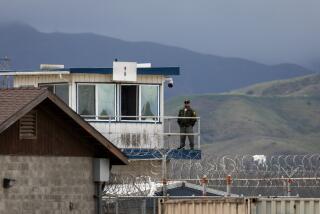Wilson Adviser Says ‘3 Strikes’ Will Save Money
- Share via
SACRAMENTO — Gov. Pete Wilson’s chief economist predicted Wednesday that the new “three strikes and you’re out” law will provide five times more in savings than it will cost.
The analysis by economist Phil Romero was immediately assailed by the authors of two of the studies cited in Romero’s five-page paper.
Romero, relying heavily on other studies, said the average criminal commits 20 crimes annually. He assumes the average yearly cost of crimes committed by each criminal is $200,000.
“The rest of it is just arithmetic,” Romero said.
By 2001, an estimated 84,000 prisoners will be serving lengthy sentences under the new law. At that time, he said, the state will realize $16.8 billion in social benefits and savings--everything from reduced property loss to lower medical bills to less spending on private security.
In that year, the Department of Corrections estimates, the cost of operating and building new prisons will be $2.7 billion.
“Even in the beginning, the benefits are at least double the costs,” Romero said. “As time goes by, as we get over the capital cost hump (for prison construction), it goes up even more. . . . Benefits average well over five times costs.”
The Department of Corrections estimates that 20 prisons must be built by the turn of the century to house criminals sentenced under the “three strikes” law. A prison costs about $500 million to build.
Romero called his analysis “very conservative” and said he was seeking to counter critics who say the “three strikes” law will bankrupt the state. Romero also said the analysis is intended to buttress Wilson’s contention that the state cannot afford to allow repeat felons out of prison.
But Peter Greenwood, a criminal justice specialist at the RAND Corp. and author of a key study cited by Romero, disagreed. “I do not in any way, shape or form see it as conservative,” Greenwood said.
He said the average out-of-pocket cost for each crime is $1,000 or $2,000. If a felon commits 20 crimes a year, the cost is between $20,000 and $40,000 a year--a fraction of the number Romero used.
Mark A.R. Kleiman, a Harvard professor of public policy and co-author of a second study cited by Romero, said Romero is “just plain wrong.”
He said the analysis assumes that every person imprisoned under “three strikes” would be committing the same number of crimes at age 60 as at age 20. Most crime is committed by younger criminals.
Romero defended his work, saying that although the average cost of an individual crime may be $2,000, murder is the “big cost driver” because a murder might cost $2.4 million when the lost wages of the victim are taken into consideration.
He cited estimates that the cost of a rape in medical treatment, lost wages, and pain and suffering is $51,000. Burglary, the most common crime that is classified as a serious crime under the “three strikes” law, costs less than $1,000.
The “three strikes” law imposes prison sentences of 25 years to life on third-time felons who have committed two prior violent or serious felonies, ranging from murder and rape to home burglary.
An initiative that duplicates the “three strikes” legislation qualified for the November ballot, acting Secretary of State Tony Miller announced Wednesday. Clerks in 43 of California’s 58 counties tallied 815,000 signatures for the measure. Signatures gathered in Los Angeles County were not even counted. The proposition needed 423,000 signatures to qualify for the ballot.
More to Read
Get the L.A. Times Politics newsletter
Deeply reported insights into legislation, politics and policy from Sacramento, Washington and beyond. In your inbox twice per week.
You may occasionally receive promotional content from the Los Angeles Times.









